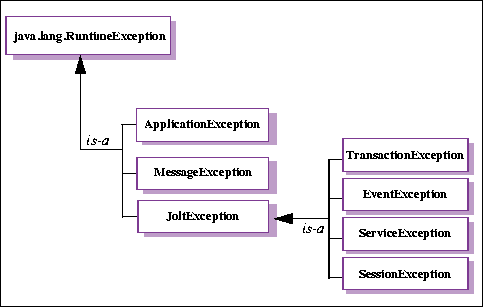TUXEDO errors are described briefly in this appendix. For a complete explanation of TUXEDO errors, refer to the TUXEDO System Reference Manual.
Jolt Error and Exception Handling
An error condition indicates that a nonrecoverable error has occurred. When an error occurs, a message is displayed and the current method stops executing.
Note: In general, these errors are not caught in your application. Normally, Java errors and exceptions are automatically caught by Jolt.
An exception indicates that a condition occurred that requires special handling to prevent the application from terminating. Exceptions can be caught and handled.
Each exception or error comes with an error code and a simple text message. The following table describes the relationship between the error code types and their messages.
The Jolt Class Library uses exceptions to report run-time problems. All Jolt exceptions extend from Java's RuntimeException and Error classes. Figure A-1 illustrates the relationship of the JoltException classes to the Java RuntimeException class.
Figure A-1 Jolt Exception Class Hierarchy

Since Java's RuntimeException and Error conditions are caught automatically by the Java virtual machine (VM), programmers can ignore these and rely on the Java VM to trap them. However, programmers must catch the exceptions or errors that are important to their particular applications so that application-specific recovery can be initiated.
ApplicationException Class
java.lang.Object
|
+----java.lang.Throwable
|
+----java.lang.Exception
|
+----java.lang.RuntimeException
|
+----bea.jolt.ApplicationException
The ApplicationException class is used by the JoltRemoteService class and its methods. The ApplicationException is thrown only when the service calls a tpreturn (TPFAIL, tpurcode, ...).
public class ApplicationException extends
java.lang.RuntimeException
ApplicationException Methods
The following methods are used with the ApplicationException class.




